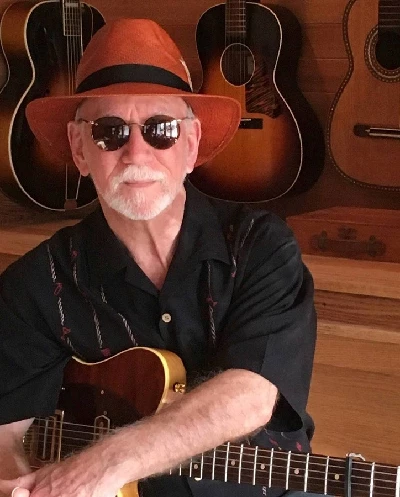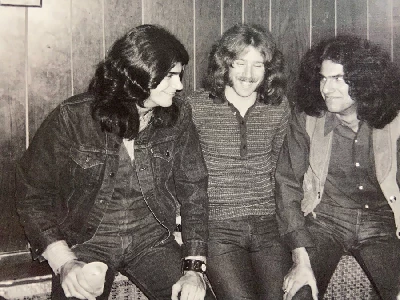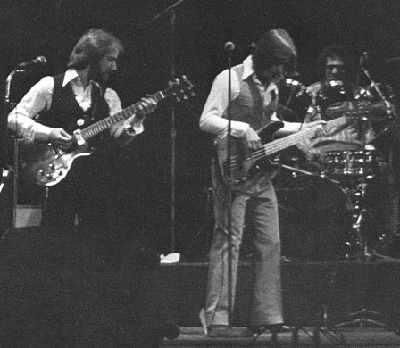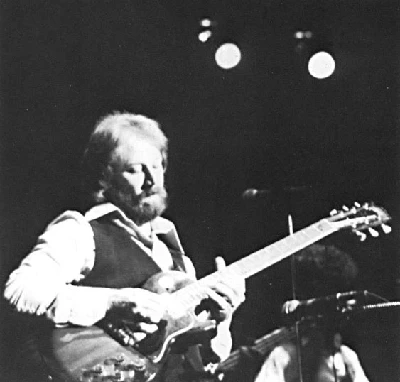published: 12 /
4 /
2022

Fingerstyle guitarist and composer Howard Emerson, who toured with rocker Billy Joel and folksinger Eric Andersen, talks Lisa Torem through selects from his extensive solo discography.
Article
In an industry, where many guitarists choose to incorporate high-decibel shredding or electronic cacophony into their repertoire, Howard Emerson truly stands out. This Long Islander doesn’t necessarily seek out the limelight, but his skill sets come to fruition in a host of other ways. A committed do-it-yourselfer, Howard’s been known to construct homemade slides with a chunk of discarded glass and a wet saw. And as for excitement, he expertly creates that, too, through a subtle means of expression known as “fingerstyle” guitar.
Howard bonded with his first six-string at age twelve. His musical journey required adjustments, however, as reading notes and/or tablature presented a challenge due to dyslexia, but Howard persevered. Luckily, he possessed an exceptional ear. That being the case, he picked up chord changes and ideas for runs by dropping the needle on his favourite tunes.
In the 1970s, Howard began teaching guitar privately, and recorded a couple of choice albums with Richard Supa. He also spent 18 months on the road and in the studio (‘Turnstiles’) with Columbia recording artist, Billy Joel. He toured alongside folksinger Eric Andersen, with whom he would eventually assist on the Arista recording, ‘Be True To You.’ More recently, Howard caught the attention of multi-instrumentalist Ben Harper.
Howard might be the last to admit this, but he’s got an additional skill in his wheel house; he can sing up a storm. In fact, Howard’s bluesy growl adds tremendous colour to his intricate instrumentals.
Howard’s solo albums: ‘Crossing Crystal Lake’ (1998), ‘A Tale to Tell (2004), ‘It Ain’t Necessarily So’ (2012), ‘The Wall Talks’ (2017) and the recent, ‘The Rhytalin Kid’ will bring hours of enjoyment to lovers of the blues, jazz, classical and traditional Celtic music.
In interview with Pennyblackmusic, he discussed open tunings, explained his affection for alliteration and revealed early influences. And if you think Howard can make a joyful noise on any old guitar, read on…
PB: Regarding ‘The Rhytalin Kid’: On the upbeat ‘Summer Island Groove,’ you’ve brightly captured the essence of a beautiful day. To me, it feels like the guitar parts are engaging in a friendly conversation. What inspired the instrumentation and the tone?
HE: It’s actually just one guitar, but I doubled it by playing the part twice, hence the particular tonality. It’s much more organic sounding than electronic doubling due to slight tuning and timing differences. I named it ‘Summer Island Groove’ after it was written, which is usually how it works. It had a light Latin feel to start with and seeing as it was written during the hot weather on Long Island the title just fell in my lap.
PB: On this album is ‘Loki’s Lament,’ which, to me, is intricate and rife with compelling starts and stops. What inspired the title and the tone?
HE: That’s a very special composition/recording on several levels, so if you’ll allow me to prattle on a bit….
PB: By all means!
HE: Musically speaking: I wrote it in open G tuning with (capo 3), so the open-string tuning is open A#. I play it off of the II mi (2 minor) chord which is C minor, hence the key is D#, not that you asked, but I’ve taught guitar since 1970, and some of my students occasionally want to know the minutiae. The stops and starts provide anticipation/tension that makes a piece more interesting, but they only insert themselves where and when they are supposed to be there. I’m just the delivery man.
Most of the ‘The Rhytalin Kid’ CD was already recorded when the studio abruptly closed for several months at the start of the pandemic, and I then contracted Covid19! As if that wasn’t bad enough, on April 1, 2020 I got the first pictures of a new guitar being built for me by luthier John Monteleone! You can’t imagine the sense of irony that coursed through me at that moment!
If his name is not familiar, Google him, but pour a glass of wine first.
Fortunately, I recovered, and even became a grandfather (Emerson Lentini born April 12, 2020) during the process! A short two months later on June 4 (my 69th birthday) I drove down to John’s shop to pick up my brand-new guitar. An auspicious first half to 2020, eh?
After a frustratingly interminable delay ‘Loki’s Lament’ was finally ready to be recorded. With my new-born Monteleone La Corsa guitar in hand, I sat down in front of a pair of AKG 414 mics and my long-time engineer/producer Fred Guarino hit the record button. It was done in a couple of takes. Fred and I have worked together since 1998 so we’re pretty efficient!
The composition itself started well over 25 years ago as a slow fingerstyle chord arrangement of an up-tempo hard rock vocal song. My interpretation was completely and utterly different than how it was originally written and recorded. I realized I’d never get any publishing/writing credit, though, so I wrote a melody within the original framework I’d created.
It stands on its own, and I’m very proud of it.
As a fan of alliteration, I named it ‘Loki’s Lament,’ after our late, big male cat, Loki. My wife, Marcela, didn’t understand what Loki would be sad about. I explained to her that he lamented not having opposable thumbs, and was therefore unable to open up cans of cat food by himself. We miss him dearly, always, every day.
PB: You also included ‘Number Three,’ written by Ben Harper, which he asked you to arrange. How did you work this out? Did you work jointly on the project or did you present Ben with a finished product?
HE: I first met Ben in April 2017 at John Monteleone’s shop when he was coming over to pick up a custom lap-style guitar that John made for him. We did a little playing together, and somehow he became a fan of my writing and playing!
Out of the blue, some months later, he called and asked if I would do an interpretation of an early instrumental he’d written. I was very honoured by the request, but frankly when I first heard the original recording, I did not have a clue what to do with it. It was short, repetitious, and almost felt like it was unfinished.
But as Ben explained to me, he views his original recording of ‘Number Three’ as a sort of Indian raga, although it is not at all Indian sounding, but more because of its repeating sections, which in that context made sense!
So, I learned the parts he wrote, and just started playing them over and over again, every day, until it told me where to find the heart of the song.
I wrote extra sections that complemented the original body of Ben’s piece, and when I finally recorded the acoustic guitar track, I presented it to Ben, along with a video shot during the actual session at Tiki Studios. Ben put on his Facebook page as a Cover of The Week.
I actually decided to put it on ‘The Rhytalin Kid’ as an afterthought, along with an overdubbed bottleneck track. By all accounts Ben was kvelling at the final results.
PB: The theme song, ‘The Rhytalin Kid’ appears to be a telling of your own experiences. Is it?
HE: It’s absolutely autobiographical.
Ever since my neurologist, Dr. Daniel Rubin, put me on Ritalin in 1996 I’ve occasionally referred to myself as “The Ritalin Kid.” Technically the prescription is for the generic Methylphenidate, but even Roget was at a loss with that word.
The reason for spelling it ‘Rhytalin’ is twofold: Firstly, it alludes to my ‘rhythmic’ playing style. The second reason is more pragmatic: Try sending an email to anyone with Ritalin in the subject header, and it’s immediately headed for the spam bin, hence the spelling!
The music was written long before the lyrics, but even as the instrumental portion was forming it was crystal clear where it was headed, much to my chagrin: Writing good lyrics, for me, is worse than pulling teeth, but I made a point of getting out a yellow pad and pen, and left it out next to where I practice. I had no choice.
PB: On your 2013 album, ‘It Ain’t Necessarily So,’ you feature solo acoustic guitar and only one vocal number, ‘Crazy Mamma.’ What made you decide to focus on vocals there?
HE: I always loved J.J. Cale’s song ‘Crazy Mama’ and I’d worked up an arrangement for it a long time ago when I’d occasionally play small acoustic clubs. I’m not much of a singer, but when I have a song I can do well I’ll put it on a recording to break things up a bit.
PB: For the song, ‘It Ain’t Necessarily So,’ you played on a maple guitar constructed by David Flammang. Why did this particular guitar serve that song so well?
HE: That entire CD was recorded with the Flammang L-40 guitar that David made for me in 2005. I think it served the whole recording pretty well!
PB: On the 2017 album, ‘The Wall Talks,’ you include ‘Fever,’ a song which has been widely covered by influential artists across time, such as Peggy Lee. It was always the lyrics that struck me as novel, but your instrumental version brings out what’s unique about the basslines and chord structures. How did you go about reconstructing ‘Fever’?
HE: I’d bought a National Resolectric guitar on a whim. It’s basically a solid body resonator guitar with a magnetic pickup, but there was something special about the acoustic tonality it had, especially when I tuned it very low.
I had been listening to the original recording of ‘Fever’ by Little Willie John, whose version is my favourite! The upright bass on Peggy Lee’s version is basically copping Little Willie John’s original arrangement.
So, after listening to it I picked up my Resolectric and started playing the three low strings (in open C tuning) and then I barred the 3rd fret, and bam! It felt good, and I knew it was the beginning riff of ‘Fever,’ so I immediately started working on completing an arrangement. In the studio I overdubbed a bottleneck track, and then had Brazilian percussionist Mauro Rofosco put conga and cymbals on it. He’s toured and recorded with the Red-Hot Chili Peppers and David Byrne.
PB: On ‘The Wall Talks,’ you re-recorded your original song, ‘Phelps Flats,’ which is a fine example of open tuning. What are the major differences between the early and later recording?
HE: The majority of what I compose and arrange is in open tunings. ‘Phelps Flats’ is in open G tuning, commonly referred to as Spanish tuning, or as “Taro Patch Tuning” in Hawaiian music.
The main difference in my two recordings is that I’d finally learned how to play it the way I heard it in my head! When I recorded it on ‘A Tale to Tell’ I was too timid, and I felt the key was a bit too low. On ‘The Wall Talks’ I played it far more confidently, so it struts the way it’s supposed to!
PB: The catchy ‘Rumble Strut’ has a crystal-clear melodic line. Was it based on a particular period of musical history or a dance?
HE: It’s basically a straight-four dead-thumb groove in open C tuning. The term ‘rumble strut’ is a behaviour seen in male Guinea Pigs. It’s what they do when they want to mate, so I guess you could say the dance it’s based on is the Horizontal Mambo. Aren’t you glad you asked?
PB: ‘Uh Oh,’ the closer on ‘The Wall Talks’ is a vocal number with one-off accompaniment. Who were the sidemen involved?
HE: A vocal number, you say? The “vocal” at the beginning is my wife, Marcela, calling me on the phone. In Spanish. She’s asking “How is it that you have such good rhythm when you play, but you can’t dance? I want to dance!”
My response is that of a deer caught in the headlights: ‘Uh-Oh!’ is my sheepish reply, and it’s basically a true story. This track is played solo fingerstyle in open D tuning on my National Resolectric, and percussionist Mauro Rofosco overdubbed rebolo, pandeiro, guiro, caxixi and chocalho on it.
PB: ‘Water Off a Duck’s Back’ sounds like, to me, a tongue-in-cheek tribute to your then-young daughter. What’s the back story and what does your daughter now think of the song?
HE: It’s absolutely about our daughter, Nicole. The lyrics pretty much tell a story that any parent can relate to. She knew the song from when I first wrote it, and was fairly amused when she heard the finished recording. Now, though, she’s a mother with a son who’s almost two years old, so my guess is that the answer will be more than amusing. Maybe I’ll ask her……
PB: Going back in time to your sophomore album, ‘A Tale To Tell’: ‘The Piping Plover Waltz’ showcases “bottleneck” technique, you recast Chuck Berry’s ‘Maybellene’ with twelve-string guitar and you tribute the late Ventures electric guitarist, Nokie Edwards’ with ‘Nokie’s Blue Bottle.’ You used six different guitars to interpret these mostly original songs. For non-guitarists, can you explain how you matched up guitars with specific songs?
HE: On ‘A Tale to Tell,’ all the bottleneck tracks, solo or overdubbed, were done with my 1930 Gibson L-5 archtop, which is an instrument usually associated with jazz players. It’s a freak of nature in that regard. I originally arranged ‘Maybellene’ on six string guitar in dropped D tuning.
One fateful day I took down a Guild twelve string at the store I worked in, and as soon as I started playing ‘Maybellene’ on it there was no going back! Other than that, I used to have this romantic notion that I should record any given song on whatever instrument birthed it, but I know better now.
PB: You began teaching guitar in person in the 1970s and then on Skype in 2008. What modifications did you have to make to successfully make this switch?
HE: Aside from being a luddite when it comes to computer programs, the biggest issue was not the face-to-face part of the lesson, but the video recording I would subsequently make for the student. It literally took me three days to make the very first video recording. The coin finally dropped when I said to myself: “Howard, your student is inside the camera. Talk to him as if he’s right here.” That’s called ‘reframing’ and it works. It’s been easy ever since.
PB: You’ve stated in previous interviews that you enjoyed and were inspired by the music of The Ventures. What did listening to this instrumental group teach you about composition and learning by ear?
HE: The Ventures recordings were very concise, well-played guitar-centric stuff. They mostly did cover arrangements of well-known standards from The American Song Book and pop songs of the day, so famous melodies were right in your face, played with a great electric twang. Nokie Edwards truly was my first guitar hero, and we became friendly later when I recorded ‘Nokie’s Blue Bottle.’
I had no choice but to work by ear because I’m dyslexic. Reading music was a real chore, especially when my ears were always way ahead of what my eyes could digest.
The simple truth is that I grew up as a frustrated drummer and bassist, and when I learned to fingerpick, I became whole and self-contained. A good melody stays with you, especially when it’s got a good beat supporting it, and I believe those traits permeate my brand of fingerstyle composing and arranging.
PB: You have also cited pianist Randy Newman as an influence, yet you play guitar. What did you glean from Newman?
HE: The fact that Ry Cooder had recorded with Randy early on certainly got me started on listening to his records, especially on his ‘12 Songs’ and ‘Sail Away’ LPs. Ry’s presence as a session player was gravy on those, and they did nothing but reinforce my love of Ry Cooder as a player/artist, but as far as Randy Newman’s effect on me?
It’s the whole thing. His voice; his lyrics; his point of view; his vocal phrasing, et al, but even more than all that: His orchestral arranging and piano voicings just feel right to me. I literally cry every time the baseball shatters the flood lights in ‘The Natural’ and the music track swells up, seriously. That music just owns me.
PB: When you are not composing or performing, what keeps you out of trouble?
HE: I’m a homebody, without a doubt. I still teach via FaceTime, and that’s gotten much easier. I hate going on vacation. My idea of a vacation is making dust with impunity, although I was raised by a mother who was a white glove 1st class, so I clean up very well!
My wife taught me how to cook a bunch of things, so I enjoy cooking. I love working in my wood shop, and gardening. I don’t really play out anymore, so instead for attention I post pictures of my projects on Facebook, which is sort of sad, but not really. Currently I’m finishing a bathroom renovation where I’ve done everything: Design, demolition, reframing, ceramic wall and floor tile, plumbing, cabinetry, etc. It’s kind of like a new composition, except that you get to experience it visually every day.
PB: Thank you.
The top photograph was taken by Nancy Schoen and the second photograph is courtesy of Liberty DeVitto.
Band Links:-
https://www.howardemerson.com/
https://www.facebook.com/howard.emerso
Play in YouTube:-
Picture Gallery:-




Visitor Comments:-
|
|
3149 Posted By: Michael Solomon, Eatons Neck New York USA on 01 Oct 2022 |
What a Terrific Interview !
|